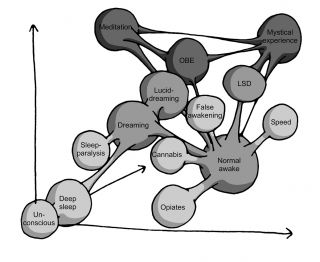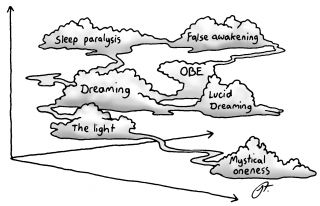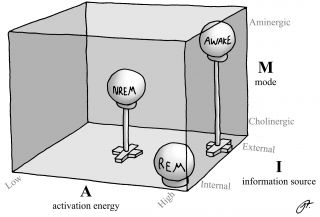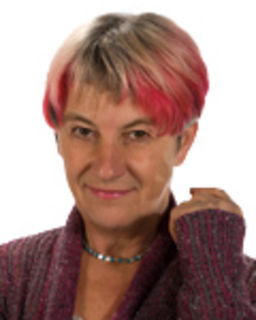Will it ever be possible?
A recent conversation on Reddit is all about an illustration from one of my books. It’s a diagram showing a 3D space with lots of different states of consciousness depicted as blobs floating in space. It includes deep sleep, dreaming, lucid dreaming, out-of-body experience, false awakening and various drug-induced states.
 What do the axes represent?’ asked one commentator, and then others began to speculate. They are unconscious and conscious; they are speed/intensity versus awareness/understanding; they are enlightenment and difficulty to achieve the state; they are connectedness to the physical world versus spiritual awareness. Then someone suggested that you might seek to understand yourself how to label the axes, and finally others hit upon the truth, ‘they don’t don't really represent anything but it's just an "what-if" idea’ and ‘this graphic is nothing more than a cool looking picture’. They are right. The diagram was just supposed to show the idea – the idea that in some way different states of consciousness can be thought of as closer or further from each other.
What do the axes represent?’ asked one commentator, and then others began to speculate. They are unconscious and conscious; they are speed/intensity versus awareness/understanding; they are enlightenment and difficulty to achieve the state; they are connectedness to the physical world versus spiritual awareness. Then someone suggested that you might seek to understand yourself how to label the axes, and finally others hit upon the truth, ‘they don’t don't really represent anything but it's just an "what-if" idea’ and ‘this graphic is nothing more than a cool looking picture’. They are right. The diagram was just supposed to show the idea – the idea that in some way different states of consciousness can be thought of as closer or further from each other.
They discussed this too. One said that sleep paralysis involves lucidity and should therefore be higher up than dreaming, others said that sleep paralysis and lucid dreaming shouldn’t be on opposite sides of dreaming or should be closer together because each can cause each other. Others discussed how different drugs are more or less similar to others or are ‘higher’ and ‘lower’.
And this is the point. Those of us who explore many states of consciousness have the intuition that some states are similar to others while some are very different – that some are easy to reach from other states while some are not. But is this intuition sound? And what does it mean?
 This is what I was discussing in my little book A Very Short Introduction to Consciousness from where the drawing came. The implication is that we can think of altered states as interconnected in a vast multi-dimensional space – with some being close to each other and others far apart. If we could accurately map this space we might be able to predict how to move from one state to another, or how to avoid falling into unpleasant or unwanted states from more desirable ones close by, or how to change frightening experiences into enjoyable ones as people sometimes do when they convert sleep paralysis into an out-of-body experience, or a flying dream into lucidity.
This is what I was discussing in my little book A Very Short Introduction to Consciousness from where the drawing came. The implication is that we can think of altered states as interconnected in a vast multi-dimensional space – with some being close to each other and others far apart. If we could accurately map this space we might be able to predict how to move from one state to another, or how to avoid falling into unpleasant or unwanted states from more desirable ones close by, or how to change frightening experiences into enjoyable ones as people sometimes do when they convert sleep paralysis into an out-of-body experience, or a flying dream into lucidity.
It would be fantastic to have such a map and be able to use it, but we don’t. That’s why my diagram just had arrows for the three axes. It was drawn by my son Jolyon Troscianko who has illustrated many of my books, and it was deliberately vague. So will we ever have such a map?
Many people have tried to make them, as I outlined in my textbook on consciousness. For example, psychologist Charles Tart mapped dreaming and other states using as axes ‘ability to hallucinate’ and ‘rationality’; neurologist Steven Laureys used ‘level of consciousness’ and ‘content of consciousness’; and sleep expert, J. Allan Hobson developed a 3D ‘AIM model’ with the dimensions being ‘activation’, ‘input-output gating’ and ‘modulation’. All these were based on scientific research. For example Hobson’s is based on based on the effects of different neurotransmitters. But there are plenty more based on shamanic states, spiritual doctrines, meditation methods or various theories of consciousness.
 The truth is that we have no generally accepted map, and the study of altered states of consciousness is still in its infancy. We don’t even know whether one map is sufficient. For example, if we mapped states in terms of their similarity would this equate to how easy it is to reach one from the other. I guess not but I do not know. So I hope to do more research on both these questions but for now we are best to stick with a simple diagram. The axes are vague because we do not yet know how to label them.
The truth is that we have no generally accepted map, and the study of altered states of consciousness is still in its infancy. We don’t even know whether one map is sufficient. For example, if we mapped states in terms of their similarity would this equate to how easy it is to reach one from the other. I guess not but I do not know. So I hope to do more research on both these questions but for now we are best to stick with a simple diagram. The axes are vague because we do not yet know how to label them.
This conversation is great fun, and after meandering around wild speculations ends up with the truth. The axes are purely imaginary. I had no specific dimensions in mind when I asked Jolyon to draw it and to put arrows for the imagined axes. The drawing is just meant to illustrate the idea that there might be a vast multi-dimensional space of states of consciousness – with some being close to each other and others far apart. One day someone will create a real map. For now we have to guess. If you want to know more there are more of Jolyon’s drawings and a review of real attempts to map states of consciousness in my textbook Consciousness: An Introduction.

Source: Jolyon Troscianko, used with permission
They discussed this too. One said that sleep paralysis involves lucidity and should therefore be higher up than dreaming, others said that sleep paralysis and lucid dreaming shouldn’t be on opposite sides of dreaming or should be closer together because each can cause each other. Others discussed how different drugs are more or less similar to others or are ‘higher’ and ‘lower’.

Source: Jolyon Troscianko, used with permission
It would be fantastic to have such a map and be able to use it, but we don’t. That’s why my diagram just had arrows for the three axes. It was drawn by my son Jolyon Troscianko who has illustrated many of my books, and it was deliberately vague. So will we ever have such a map?
Many people have tried to make them, as I outlined in my textbook on consciousness. For example, psychologist Charles Tart mapped dreaming and other states using as axes ‘ability to hallucinate’ and ‘rationality’; neurologist Steven Laureys used ‘level of consciousness’ and ‘content of consciousness’; and sleep expert, J. Allan Hobson developed a 3D ‘AIM model’ with the dimensions being ‘activation’, ‘input-output gating’ and ‘modulation’. All these were based on scientific research. For example Hobson’s is based on based on the effects of different neurotransmitters. But there are plenty more based on shamanic states, spiritual doctrines, meditation methods or various theories of consciousness.

Source: Jolyon Troscianko, used with permission
This conversation is great fun, and after meandering around wild speculations ends up with the truth. The axes are purely imaginary. I had no specific dimensions in mind when I asked Jolyon to draw it and to put arrows for the imagined axes. The drawing is just meant to illustrate the idea that there might be a vast multi-dimensional space of states of consciousness – with some being close to each other and others far apart. One day someone will create a real map. For now we have to guess. If you want to know more there are more of Jolyon’s drawings and a review of real attempts to map states of consciousness in my textbook Consciousness: An Introduction.

No comments:
Post a Comment